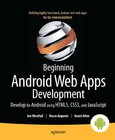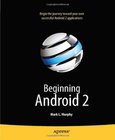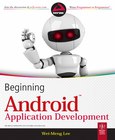Beginning Android

Book Details:
| Publisher: | Apress |
| Series: | Apress , Beginning |
| Author: | Mark Murphy |
| Edition: | 1 |
| ISBN-10: | 1430224193 |
| ISBN-13: | 9781430224198 |
| Pages: | 384 |
| Published: | Jun 26 2009 |
| Posted: | Nov 19 2014 |
| Language: | English |
| Book format: | |
| Book size: | 14.87 MB |
Book Description:
Learn how to develop applications for Android mobile devices using simple examples, ready to run with your copy of the software development kit. Author and Android columnist, writer, developer, and community advocate Mark L. Murphy shows you what you need to know to get started on programming Android applicationseverything from crafting graphical user interfaces to using GPS, accessing web services, and more! The Android development platform, created by Google and the Open Handset Alliance, is a platform in its truest sense, encompassing hundreds of classes beyond the traditional Java classes and open source components that ship with the SDK. Some Android books race through the material, trying to cover as much ground as possible in as few pages as possible. Experienced writer and community advocate Mark Murphy shows you how to develop Android applications simply and with care. The book includes dozens of sample projects, ready to run with your copy of the SDKnot just one huge project where you have difficulty finding the specific examples of the technique you are looking for. You can even get these sample programs online at Apress.com. What youll learn Discover what Android is and how to use Android to build Java-based mobile applications for Google Phones G1 and more phones as they hit the market Work with the new Android 1.x SDK Create user interfaces using both the Android Widget framework and the built-in WebKit-powered web browser components Use scripting with BeanShell Work with menu inflation, fonts, SDK tools, rotation events, and more Work with TabActivity, MyLocationOverlay, DDMS, and more Utilize the distinctive capabilities of the Android engine including maps, Internet access, integrated search, media playback, and more Use and create similar sample Android applications for services, content providers, mapping, and location-based services/events. Who this book is for This book is aimed at people new to mobile development, perhaps even to Java itself. Table of Contents The Big Picture Project Structure Inside the Manifest Creating a Skeleton Application Using XML-Based Layouts Employing Basic Widgets Working with Containers Using Selection Widgets Getting Fancy with Lists Employing Fancy Widgets and Containers Applying Menus Fonts Embedding the WebKit Browser Showing Pop-Up Messages Dealing with Threads Handling Activity Lifecycle Events Using Preferences Accessing Files Working with Resources Managing and Accessing Local Databases Leveraging Java Libraries Communicating via the Internet Creating Intent Filters Launching Activities and Sub-Activities Finding Available Actions via Introspection Handling Rotation Using a Content Provider Building a Content Provider Requesting and Requiring Permissions Creating a Service Invoking a Service Alerting Users Via Notifications Accessing Location-Based Services Mapping with MapView and MapActivity Handling Telephone Calls Searching with SearchManager Development Tools Where Do We Go From Here?
Download Link:
Related Books:
Beginning Android Web Apps Development
Develop for Android using HTML5, CSS3, and JavaScript
With Beginning Android Web Apps Development, you'll learn how to apply HTML5, CSS3, JavaScript, Ajax and other Web standards for use on the Android mobile platform, by building a variety of fun and visually stimulating games and other web applications! If you've done some basic web development, andyou want to build your skills to createexceptionalweb apps, you'll findeverything you seek in the discussions and examples in this book. Each application you'll build in Beginning Android Web Application Development will show you solutions that you can apply to many of your own projects. Each example shares techniques and coding solutions that will inspire your own work. You'll learn how to tie your Android apps into Twitter through two apps that you'll ...
Beginning Android 2
The Android development platform, created by Google and the Open Handset Alliance, is a platform in its truest sense, encompassing hundreds of classes beyond the traditional Java classes and open source components that ship with the SDK. With Beginning Android 2, youll learn how to develop applications for Android 2.x mobile devices, using simple examples that are ready to run with your copy of the software development kit. Author, Android columnist, writer, developer, and community advocate Mark L. Murphy will show you what you need to know to get started programming Android applications, including how to craft graphical user interfaces, use GPS, and access web services. What youll learn Discover Android and how to use it to build Java-based mobile ...
Beginning Android Games
Beginning Android Games offers everything you need to join the ranks of successful Android game developers. You'll start with game design fundamentals and programming basics, and then progress towards creating your own basic game engine and playable games. This will give you everything you need to branch out and write your own Android games. The potential user base and the wide array of available high-performance devices makes Android an attractive target for aspiring game developers. Do you have an awesome idea for the next break-through mobile gaming title?Beginning Android Games will help you kick-start your project. The book will guide you through the process of making several example games for the Android platform, and involves a wide range of...
Beginning Android
Application Development
Create must-have applications for the latest Android OSThe Android OS is a popular and flexible platform for many of today's most in-demand mobile devices. This full-color guide offers you a hands-on introduction to creating Android applications for the latest mobile devices. Veteran author Wei Meng Lee accompanies each lesson with real-world examples to drive home the content he covers. Beginning with an overview of core Android features and tools, he moves at a steady pace while teaching everything you need to know to successfully develop your own Android applications.Explains what an activity is and reviews its lifecycleZeroes in on customizing activities by applying styles and themesLooks at the components of a screen, including LinearLayout, Abs...
2007 - 2021 © eBooks-IT.org




